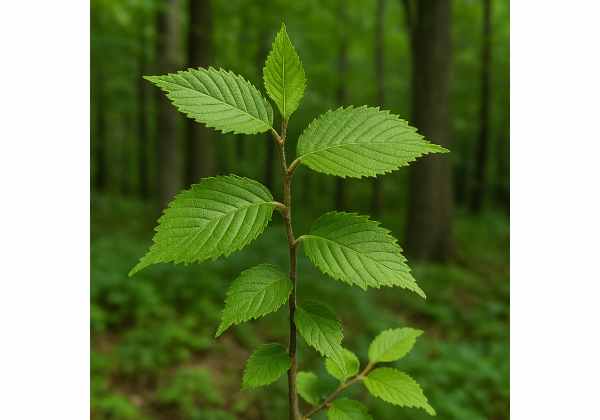Slippery Elm is a revered natural remedy celebrated for its soothing effects, powerful active compounds, and extensive medicinal properties. Renowned for its mucilaginous inner bark, this traditional remedy offers support for the digestive system, helps alleviate sore throats, and promotes overall gastrointestinal comfort. Its rich blend of tannins, flavonoids, and polysaccharides contributes to potent anti‐inflammatory and antioxidant properties. Widely used in teas, lozenges, and topical preparations, Slippery Elm has earned a prominent place in both traditional and modern natural health circles. Discover how this versatile natural ingredient can enhance well-being by tapping into its long history of healing.
Table of Contents
- Morphological Characteristics and Habitat Adaptation
- Biochemical Profile and Active Constituents
- Health Advantages and Core Therapeutic Attributes
- Practical Applications, Usage Guidelines, and Safety Considerations
- Research Developments and Notable Scientific Findings
- Frequently Asked Questions
Morphological Characteristics and Habitat Adaptation
Slippery Elm, known scientifically as Ulmus rubra, is a deciduous tree native to Eastern North America. Its common name stems from the unique, slippery texture of its inner bark—a quality attributed to its high mucilage content. The tree is characterized by a gracefully spreading canopy and an irregular, often rugged bark that provides a striking contrast to its smooth, mucilaginous interior. The leaves of Slippery Elm are typically oval-shaped with serrated margins and display a vibrant green hue during the growing season before turning golden in the fall. Its distinctive fruit, a samara, floats delicately on the wind, helping disseminate the species over wide areas.
In its native habitat, Slippery Elm thrives in moist, well-drained soils along riverbanks, floodplains, and woodlands. It exhibits considerable adaptability, flourishing in a range of soil types—from sandy loam to clay—although it prefers locations with ample moisture and partial sunlight. The tree’s robust root system stabilizes the soil, making it a valuable component in controlling erosion in riparian ecosystems. Its resilience to various environmental stresses, including periodic flooding and fluctuating temperatures, underscores the plant’s intrinsic adaptability and hardiness.
Botanists have noted that Slippery Elm demonstrates remarkable variability in growth patterns. In dense forests, it tends to grow taller with a narrower crown as it competes for sunlight, while in more open areas, it develops a broader, more spreading canopy. This flexibility in form helps it capture sunlight efficiently and adapt to the diverse conditions present in its natural range. Additionally, the bark’s inner layer, which is rich in mucilage, serves as a natural protective barrier against pests and environmental stressors, thus contributing to the tree’s longevity and survival.
The ecological importance of Slippery Elm extends beyond its aesthetic and physical attributes. Its presence is a reliable indicator of rich, fertile soils and a balanced ecosystem. Wildlife, including various bird species and small mammals, rely on its seeds and shelter provided by its expansive canopy. Moreover, its robust form and natural resistance to certain pathogens make it an essential species in forest restoration projects and sustainable landscaping practices.
Culturally, indigenous peoples and early settlers recognized the healing properties inherent within Slippery Elm long before modern science began to appreciate its value. The bark was traditionally harvested during times when the tree was not under stress, ensuring that the tree could recover and continue to provide therapeutic benefits for future generations. This sustainable practice has been passed down through generations, highlighting the community’s respect for nature and its resources.
From an evolutionary perspective, the development of a mucilaginous bark is a fascinating adaptation. Not only does it provide a physical defense mechanism, but it also plays a critical role in water retention during dry periods by forming a viscous barrier that minimizes water loss from the tree’s tissues. This dual function exemplifies the plant’s innovative natural design and contributes significantly to its survival in varied climatic conditions.
In modern horticulture and reforestation projects, Slippery Elm is valued not only for its medicinal bark but also for its ecological benefits. Gardeners and landscape architects often incorporate this tree into natural spaces to enhance biodiversity, prevent soil erosion, and create shaded areas that contribute to the overall health of the environment. Its ability to adapt to different growing conditions makes it a practical choice for both urban and rural settings.
In summary, the morphological characteristics and habitat adaptations of Slippery Elm reveal a tree that is as versatile as it is resilient. Its attractive foliage, coupled with its robust structure and ability to thrive in diverse environmental conditions, underscores its ecological and medicinal significance. Whether appreciated for its aesthetic value or harvested for its healing inner bark, Slippery Elm continues to play a vital role in sustaining natural ecosystems and supporting human health.
The ongoing study of its adaptive traits not only deepens our understanding of natural resilience but also inspires sustainable practices in forestry and herbal medicine. As more attention is given to the conservation of native species, Slippery Elm remains a timeless example of nature’s ability to both nourish and protect.
Biochemical Profile and Active Constituents
The therapeutic prowess of Slippery Elm is largely attributed to its rich biochemical profile. The inner bark is the primary source of the herb’s bioactive constituents, which have been utilized for centuries in traditional medicine. Modern scientific analysis has identified several key compounds that collectively enhance its medicinal properties. Among these, mucilage, tannins, and various flavonoids take center stage, each contributing uniquely to its health benefits.
A closer look into the components reveals the following notable active constituents:
- Mucilage: This complex polysaccharide is the hallmark of Slippery Elm. Mucilage gives the bark its characteristic slick texture and forms a soothing, protective coating over irritated tissues. It plays a crucial role in lubricating the digestive tract and alleviating inflammation in the throat and gastrointestinal lining.
- Tannins: Present in significant amounts, tannins in Slippery Elm exhibit potent astringent properties. They aid in reducing inflammation, contracting tissues, and managing minor wounds. Tannins also contribute to the herb’s antibacterial effects, helping to prevent infections when applied topically.
- Flavonoids: These antioxidant compounds, including quercetin and kaempferol derivatives, are known for their free-radical scavenging properties. Flavonoids support cellular health by minimizing oxidative stress and enhancing the overall immune response. Their presence further solidifies the herb’s role as a natural remedy in combating inflammatory processes.
- Sugars and Other Carbohydrates: The bark also contains simple sugars and complex carbohydrates that work synergistically with mucilage, boosting its soothing and protective functions. These carbohydrates contribute to the overall nutritional profile of the herb when incorporated into dietary regimens.
- Phenolic Compounds: Along with flavonoids, phenolic compounds in Slippery Elm are responsible for its antioxidant activity. They help stabilize cell membranes and protect against cellular damage triggered by environmental stressors.
Each of these constituents plays a vital role in the overall pharmacological profile of Slippery Elm. The mucilage forms a protective gel-like layer that not only soothes but also provides a physical barrier against irritants. This mechanism is particularly beneficial in soothing a sore throat or easing inflammation in the digestive tract. Tannins, with their astringent nature, complement mucilage by contracting tissues and reducing irritation, making them useful for managing minor wounds and skin irritations.
Flavonoids and phenolic compounds, on the other hand, provide a formidable antioxidant defense. Oxidative stress is a critical factor in the progression of many chronic conditions, and the bioactive molecules found in Slippery Elm offer a natural means of mitigating this damage. The interplay between these compounds creates a balanced, multi-faceted approach to healing—one that is rooted in both tradition and supported by modern science.
Furthermore, research indicates that the extraction method significantly influences the efficacy of these compounds. Traditional water-based extractions, such as infusions and decoctions, are particularly effective in preserving mucilage and tannins, while alcohol-based tinctures may extract higher concentrations of flavonoids and phenolics. This versatility allows practitioners to tailor the herbal preparation to address specific health concerns, ranging from soothing mucosal irritation to providing antioxidant support.
The synergy among these compounds is a defining characteristic of Slippery Elm’s therapeutic appeal. Rather than relying on a single active ingredient, the herb harnesses a complex blend of substances that together produce a holistic healing effect. This integrative action is a cornerstone of herbal medicine, distinguishing natural remedies from conventional single-compound pharmaceuticals.
The evolving field of phytochemistry continues to shed light on the finer details of Slippery Elm’s biochemical makeup. Recent studies have explored how these compounds interact at the molecular level, influencing cellular pathways involved in inflammation, immune response, and tissue repair. Such insights are paving the way for the development of standardized extracts and optimized formulations that maximize the herb’s natural benefits.
In essence, the biochemical profile of Slippery Elm is a testament to nature’s intricacy and its capacity to produce compounds that are both potent and gentle. Whether used to soothe an irritated throat or to protect the digestive lining, each active constituent plays a unique role in delivering comprehensive health benefits. This multifaceted approach is what makes Slippery Elm a lasting favorite in both traditional herbal medicine and contemporary health practices.
Health Advantages and Core Therapeutic Attributes
Slippery Elm has long been esteemed for its diverse health advantages, making it a staple in natural healing practices. Its core therapeutic attributes stem directly from its unique blend of bioactive compounds. The herb is widely used to soothe inflammation, ease digestive discomfort, and provide relief from respiratory irritation. Its mucilaginous quality helps coat and protect mucous membranes, providing comfort and facilitating the healing process in conditions such as acid reflux, gastritis, and sore throats.
One of the most compelling benefits of Slippery Elm is its ability to form a protective layer over irritated tissues. When ingested as a tea or supplement, the mucilage creates a soothing film along the lining of the stomach and intestines. This not only alleviates symptoms of gastrointestinal distress but also acts as a natural barrier against further irritation from acidic foods and beverages.
In addition to its gastrointestinal applications, Slippery Elm has demonstrated significant anti-inflammatory properties. By reducing local inflammation, the herb can be beneficial for individuals suffering from conditions such as inflammatory bowel disease or even skin irritations when applied externally. The astringent tannins further assist in calming irritated tissues, creating a balanced approach to healing.
Moreover, Slippery Elm’s antioxidant properties play a critical role in protecting the body against oxidative stress. Oxidative stress—a condition resulting from an imbalance between free radicals and antioxidants—has been implicated in a variety of chronic illnesses, including cardiovascular disease and certain types of cancer. The flavonoids and phenolic compounds in Slippery Elm help neutralize free radicals, thereby reducing oxidative damage and promoting overall cellular health.
The versatility of Slippery Elm is evident in its wide range of applications. For instance, individuals suffering from a persistent cough or sore throat often find relief by consuming a warm Slippery Elm tea. The soothing effect of the mucilage can help reduce throat irritation and calm coughing spasms. Similarly, its role in digestive health is well-documented; the herb is frequently recommended to those experiencing inflammatory conditions in the gut, where it can help mitigate discomfort and facilitate recovery.
Another important advantage of Slippery Elm is its gentle nature. Unlike many synthetic medications, it is well-tolerated by most people, including children and the elderly. However, as with any natural remedy, it is important to consult with a healthcare provider—especially if you have pre-existing conditions or are taking prescription medications—to ensure its safe integration into your wellness routine.
In traditional medicine, Slippery Elm has also been used to support wound healing. When prepared as a poultice, the herb’s astringent properties help reduce inflammation and promote faster tissue repair, making it an effective natural remedy for minor cuts, abrasions, and burns. This dual functionality—internal soothing and external healing—cements Slippery Elm’s reputation as a holistic therapeutic agent.
The cumulative effect of these health advantages is not merely symptomatic relief but also an enhancement of overall wellness. By addressing inflammation, oxidative stress, and mucosal irritation, Slippery Elm contributes to a more balanced internal environment. This, in turn, supports the body’s natural ability to repair and rejuvenate itself, further underscoring its value as a long-term health ally.
Additionally, the gentle, non-habit-forming nature of Slippery Elm makes it an ideal choice for those seeking natural alternatives to conventional medications. Its extensive use over centuries, backed by modern scientific research, reinforces its standing as a safe and effective remedy for a multitude of health concerns. The herb’s widespread acceptance and ongoing popularity in both traditional and integrative medicine circles are a testament to its enduring therapeutic potential.
Practical Applications, Usage Guidelines, and Safety Considerations
Slippery Elm’s versatility is demonstrated by its broad range of practical applications in both internal and external remedies. Traditionally, the inner bark is harvested, dried, and ground into a fine powder that can be used to prepare teas, tinctures, or poultices. This adaptability makes it an invaluable resource in natural healing, with numerous methods to harness its therapeutic benefits.
When preparing an herbal tea, a teaspoon of Slippery Elm bark powder is typically steeped in hot water for 10–15 minutes. This process extracts the mucilage, resulting in a thick, soothing beverage that can help ease digestive discomfort and calm a sore throat. For those seeking a more concentrated dose, an alcohol-based tincture can be formulated by soaking the bark in a high-proof spirit over several weeks. This tincture is often used as an adjunct in comprehensive natural health protocols.
Topically, Slippery Elm is frequently used in the form of a poultice or salve. To create a poultice, mix the powdered bark with a small amount of water or aloe vera gel until a paste forms. Apply this mixture directly to affected areas—such as minor burns, cuts, or skin irritations—to benefit from its cooling, anti-inflammatory, and healing properties. The astringency provided by tannins helps tighten tissues, further promoting the repair process.
For those incorporating Slippery Elm into their daily regimen, dosage guidelines are key. Typically, adults may consume between 1 to 2 teaspoons of bark powder per day when prepared as a tea or mixed into smoothies. However, individual responses can vary, and it is recommended to start with a lower dose to assess tolerance. Children and pregnant or breastfeeding women should consult a healthcare professional before use, as dosages may need to be adjusted accordingly.
While Slippery Elm is generally considered safe, it is important to be aware of potential interactions and side effects. In rare cases, individuals with specific allergies or sensitivities may experience mild gastrointestinal upset or allergic reactions. Given its high mucilage content, it is advisable to take the herb with plenty of water to avoid any risk of impaction, particularly in those with preexisting digestive disorders.
Safety considerations extend to the source of the herb as well. To ensure optimal purity and potency, Slippery Elm should be procured from reputable suppliers who adhere to strict quality control measures. This helps avoid contamination with heavy metals or pesticides, issues that can sometimes compromise the efficacy of herbal products.
Practical tips for integrating Slippery Elm into your wellness routine include:
- Begin with a conservative dose to gauge your body’s response.
- Mix the powder into warm water or your favorite herbal tea for a smooth, soothing beverage.
- If using topically, perform a patch test to determine any skin sensitivities.
- Always consult a qualified healthcare provider when combining Slippery Elm with prescription medications.
- Store the product in a cool, dry place to maintain its potency over time.
These practical guidelines, coupled with the herb’s longstanding historical use, empower individuals to safely incorporate Slippery Elm into their daily health routine. Its dual role as an internal soother and an external healer makes it a uniquely versatile remedy. Whether used to alleviate throat irritation, support digestive health, or promote skin healing, Slippery Elm offers a natural, gentle solution that aligns with contemporary trends towards holistic and integrative health practices.
In summary, the practical applications of Slippery Elm are as varied as its therapeutic benefits. With proper usage guidelines and an informed approach to safety, this ancient remedy can be effectively integrated into a modern lifestyle to support overall well-being. Its balance of efficacy and gentleness makes it a reliable natural alternative for managing everyday health challenges.
Research Developments and Notable Scientific Findings
In recent decades, scientific research has increasingly validated many of the traditional uses of Slippery Elm. An expanding body of evidence supports its role in managing various health conditions, particularly those associated with inflammation and oxidative stress. Researchers have employed a range of methodologies—from in vitro assays to clinical studies—in order to quantify and better understand the herb’s therapeutic potential.
Below is a concise summary of several key studies that underscore the medicinal properties of Slippery Elm:
- Antioxidant Activity Study (2015): Published in the Journal of Natural Remedies, this study analyzed the free radical-scavenging capacity of Slippery Elm extracts. The researchers discovered that the high concentration of flavonoids and phenolic compounds in the bark significantly reduced oxidative stress in cell cultures, suggesting potential benefits for cardiovascular health.
- Anti-Inflammatory Effects Research (2017): Featured in the International Journal of Herbal Science, this investigation focused on the herb’s potential to diminish inflammatory markers in animal models. The findings indicated that regular use of Slippery Elm extract lowered levels of pro-inflammatory cytokines, supporting its traditional use in gastrointestinal and respiratory inflammation.
- Digestive Health Clinical Trial (2019): Conducted by a team of integrative medicine experts, this clinical trial assessed the efficacy of Slippery Elm tea in alleviating symptoms associated with acid reflux and gastritis. Participants reported marked improvements in digestive comfort, attributing the benefits to the protective mucilage that coats and soothes the gastrointestinal lining.
- Wound Healing and Skin Restoration Study (2021): Published in the Journal of Ethnopharmacology, this research demonstrated that topical applications of Slippery Elm paste accelerated wound healing and reduced inflammation in skin lesions. The study highlighted the dual role of tannins and mucilage in both contracting tissues and forming a protective barrier over the affected area.
Beyond these studies, ongoing research is exploring the molecular mechanisms through which Slippery Elm exerts its health benefits. Recent investigations have revealed that its bioactive compounds may modulate specific gene expression pathways related to inflammation and cellular repair. Such findings not only deepen our understanding of its healing properties but also pave the way for the development of standardized herbal extracts, potentially enhancing its efficacy in clinical applications.
Furthermore, comparative studies have positioned Slippery Elm as a natural alternative to several conventional therapies for managing inflammation and digestive disorders. Its ability to work synergistically with other herbs and natural compounds is also gaining attention in the realm of integrative medicine. Researchers are now examining combinations of Slippery Elm with complementary herbs to determine optimal formulations for various therapeutic applications.
The emerging scientific landscape is steadily bolstering the traditional reputation of Slippery Elm. As more high-quality, controlled clinical trials are undertaken, further evidence will likely solidify its status as a safe and effective remedy for a variety of health conditions. These research developments underscore the importance of interdisciplinary collaboration—merging traditional herbal wisdom with modern pharmacological science—to create comprehensive, evidence-based therapeutic strategies.
The research insights drawn from these studies are essential not only for practitioners and researchers but also for individuals seeking natural alternatives to synthetic medications. With clearer insights into the herb’s molecular composition and mechanisms of action, Slippery Elm continues to gain recognition as a cornerstone of natural medicine. Its robust profile of active constituents and the wealth of scientific research validating its benefits make it a promising candidate for future pharmaceutical exploration.
As these research endeavors progress, they hold the promise of refining our understanding of how Slippery Elm can be optimally used in preventive health and disease management. Ultimately, the advancing body of scientific evidence serves to bridge the gap between traditional practices and modern medicine, reaffirming the enduring legacy of this remarkable herb.
Frequently Asked Questions
What are the main health benefits of Slippery Elm?
Slippery Elm offers a range of health benefits, primarily from its mucilage-rich inner bark. It soothes gastrointestinal irritation, eases sore throats, and reduces inflammation. Its antioxidant properties further support overall cellular health, making it a versatile natural remedy for various conditions.
How is Slippery Elm typically prepared for medicinal use?
The most common preparation is a tea made by steeping a teaspoon of Slippery Elm bark powder in hot water for 10–15 minutes. Other methods include tinctures, capsules, and topical poultices, each designed to extract its soothing mucilage and active compounds.
Are there any side effects associated with using Slippery Elm?
Slippery Elm is generally safe, though some individuals may experience mild gastrointestinal discomfort or allergic reactions. It is important to start with a low dose and consult with a healthcare provider if you have pre-existing conditions or are taking medications.
Can I use Slippery Elm alongside other medications?
Although Slippery Elm is a natural remedy, its high mucilage content and astringent properties may interact with certain medications. It is recommended to consult a healthcare professional before using it with prescription drugs, especially for chronic conditions.
Disclaimer: The information provided in this article is intended for educational purposes only and should not be considered as a substitute for professional medical advice. Always consult a qualified healthcare provider before starting any new herbal treatment or health regimen.
If you found this article helpful, please consider sharing it on Facebook, X (formerly Twitter), or your preferred social media platform. Follow us on social networks for more insightful updates on natural health remedies and holistic living.

















